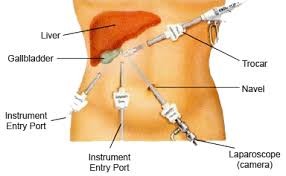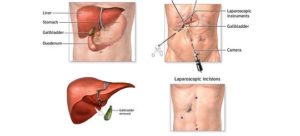Brief about laparoscopic cholecystectomy
The surgery to remove the gallbladder is called a cholecystectomy (chol-e-cys-tec-toe-mee). The gallbladder is removed through a 5 to 8 inch long incision, or cut, in your abdomen. During an open cholecystectomy, the cut is made just below your ribs on the right side and goes to just below your waist.
A less invasive way to remove the gallbladder is called laparoscopic cholecystectomy. This surgery uses a laparoscope (an instrument used to see the inside of your body) to remove the gallbladder. It is performed through several small incisions rather than through one large incision, usually 4 incisions, each one inch or less in length.
What Is The Gallbladder?
Gallbladder location the gallbladder is a pear shaped small organ in the upper right part of the abdomen that rests beneath your liver. Gallbladders primary purpose is to store bile (digestive fluid) produced by the liver. Bile is release from the gallbladder after eating that helps in digestion process.
What Causes Gallbladder Problems?
In majority of the cases, the problem associated with gallbladder is due to the presence of gallstones. Gallstones are small, hard masses formed from cholesterol, bile salts and waste products. They often cause no symptoms and in many cases remain undetected. In certain cases, gallstones block the flow of bile out of the gallbladder causing the swelling of gallbladder that results in abdominal pain, indigestion and vomiting.
Gall Bladder Symptoms
The symptoms from a diseased gall bladder include pain, nausea, loss of appetite and features of infection such as fever and feeling unwell. Jaundice (“going yellow”) and itch can occur when there are stones in the bile duct or when the gallbladder is severely inflamed.
The pain is classically “colicky” meaning it comes and goes or pulsates, usually occurs in the upper right side of the abdomen or upper abdomen and can radiate around to the back. It typically occurs after a fatty meal but can occur any time. If it lasts only a few minutes to hours it is called biliary colic, but if it lasts longer than this it might represent an infection or severe inflammation of the gallbladder, which is called cholecystitis. In cholecystitis the pain is more severe and constant and can last for several hours or days.
Common Indications are:
- Cholelithiasis
- Mucocele gall bladder
- Empyema ball bladder
- Cholesterosis
- Typhoid carrier
- Porcelain gallbladder
- Acute Cholecystitis (calculus and calculus)
- Adenomatous gall bladder polyps
How to Prepare?
To prepare for a cholecystectomy, your surgeon may ask you to:
Eat nothing the night before your surgery. You may drink a sip of water with your medications, but avoid eating and drinking at least four hours before your surgery.
Stop taking certain medications and supplements. Tell your doctor about all the medications and supplements you take. Continue taking most medications as prescribed. Your doctor may ask you to stop taking certain medications and supplements because they may increase your risk of bleeding.
Why Is a Laparoscopic Gallbladder Removal Performed?
The main reason for having a gallbladder removed is the presence of gallstones and the complications they cause.
The presence of gallstones is called cholelithiasis. Gallstones from inside the gallbladder from substances in the bile that becomes solid. They can be as small as a grain of sand and as large as a golf ball.
You might also need this type of surgery if you have the following:
- Biliary dyskinesia, which occurs when the gallbladder doesn’t fill or empty correctly due to a defect.
- choledocholithiasis, which occurs when gallstones move to the bile duct and potentially cause a blockage that prevents the gallbladder from draining
- cholecystitis, which is an inflammation of the gallbladder
- pancreatitis, which is an inflammation of the pancreas
Laparoscopic surgery is preferred over open surgery because the smaller incisions that are made reduce your risk of infection, bleeding, and recovery time.
What are the Advantages of Performing Laparoscopic Gallbladder Removal?
Rather than a five to seven inch incision, the operation requires only four small openings in the abdomen.
- Patients usually have minimal post-operative pain.
- Patients usually experience faster recovery than open gallbladder surgery patients.
- Most patients go home the same day of the surgery and enjoy a quicker return to normal activities.
After a Laparoscopic Gallbladder Removal
The symptoms after the gallbladder removal surgery are mild and rare, but you may experience some diarrhoea.
Walking is usually encouraged as soon as you’re feeling better. Your doctor will instruct you about when you’ll be ready for most normal activities. Full recovery typically takes a week.
You’ll be in charge of caring for your incision wounds while you recover. This includes washing them properly. Most people can shower the day after surgery.
Your doctor will remove the stitches at a follow-up appointment.
Risks
A cholecystectomy carries a small risk of complications including:
- Bile leak
- Bleeding
- Blood clots
- Heart problems
- Infection
- Injury to nearby structures, such as the bile duct, liver and small intestine
- Pancreatitis
- Pneumonia
Your risk of complications depends on your overall health and the reason for your cholecystectomy.
How Surgery is done?
Laparoscopic gallbladder surgery camera.gif (cholecystectomy) removes the gallbladder camera.gif and gallstones through several small cuts (incisions) in the abdomen. The surgeon inflates your abdomen with air or carbon dioxide in order to see clearly.
The surgeon inserts a lighted scope attached to a video camera (laparoscope) into one incision near the belly button. The surgeon then uses a video monitor as a guide while inserting surgical instruments into the other incisions to remove your gallbladder.
Before the surgeon removes the gallbladder, you may have a special X-ray procedure called intraoperative cholangiography, which shows the anatomy of the bile ducts.
You will need general anaesthesia for this surgery, which usually lasts 2 hours or less.
After surgery, bile flows from the liver (where it is made) through the common bile duct and into the small intestine. Because the gallbladder has been removed, the body can no longer store bile between meals. In most people, this has little or no effect on digestion.
In 5 to 10 out of 100 laparoscopic gallbladder surgeries in the United States, the surgeon needs to switch to an open surgical method that requires a larger incision.1 Examples of problems that can require open rather than laparoscopic surgery include unexpected inflammation, scar tissue, injury, and bleeding.
What to Expect After Surgery
You may have gallbladder surgery as an outpatient, or you may stay 1 or 2 days in the hospital.
Most people can return to their normal activities in 7 to 10 days. People who have laparoscopic gallbladder surgery are sore for about a week. But in 2 to 3 weeks they have much less discomfort than people who have open surgery. No special diets or other precautions are needed after surgery.
Why It Is Done
Laparoscopic gallbladder surgery is the best method of treating gallstones that cause symptoms, unless there is a reason that the surgery should not be done.
Laparoscopic surgery is used most commonly when no factors are present that may complicate the surgery.
What to expect at home?
Recovering from laparoscopic cholecystectomy will take about 1 to 3 weeks for most people. You may have some of these symptoms as you recover:
- Pain in your belly. You may also feel pain in one or both shoulders. This pain comes from the gas still left in your belly after the surgery. The pain should ease over several days to a week.
- A sore throat from the breathing tube. Sucking on ice chips or gargling may be soothing.
- Nausea and maybe throwing up. Your surgeon can provide you with nausea medicine if needed.
- Loose stools after eating. This may last 4 to 8 weeks. However, in some cases it can last longer.
- Bruising around your wounds. This will go away on its own.
- Skin redness around your wounds. This is normal.
Prepare for your recovery
Plan ahead for your recovery after surgery. For instance:
Plan for a hospital stay. Most people go home the same day of their cholecystectomy, but complications can occur that require one or more nights in the hospital. If the surgeon needs to make a long incision in your abdomen to remove your gallbladder, you may need to stay in the hospital longer.
It’s not always possible to know ahead of time what procedure will be used. Plan ahead in case you need to stay in the hospital by bringing personal items, such as your toothbrush, comfortable clothing, and books or magazines to pass the time.
Find someone to drive you home and stay with you. Ask a friend or family member to drive you home and stay close the first night after surgery.
After surgery Activities
Start walking after surgery. Begin your everyday activities as soon as you feel up to it. Move around the house and shower, and use the stairs during your first week home. If it hurts when you do something, stop doing that activity.
You may be able to drive after 2 or 3 days if you are not taking strong pain drugs (narcotics). You may lift 15 pounds (7 kilograms) or less. DO NOT do any heavy lifting or straining for the first 1 to 2 weeks.
You may be able to go back to a desk job within a week. Talk to your health care provider if your work is physical.
Exercise after Laparoscopic Surgery
Recovery from laparoscopic surgery is much faster and exercise can be continued sooner. Avoid heavy activity for the first 24 to 48 hours. However walking during this time is essential and you should get up and walk as much as you can. Start slowly and increase your activity according to your body. Usually you should avoid strenuous activity for three to five days, but this differs between persons and their underlying fitness. Wait until your follow-up, which should be seven to 14 days after your surgery, before returning to your typical pre-surgery activity.
Results
A cholecystectomy can relieve the pain and discomfort of gallstones. Conservative treatments, such as dietary modifications, usually can’t stop gallstones from recurring. A cholecystectomy is the only way to prevent gallstones.
Most people won’t experience digestive problems after a cholecystectomy. Your gallbladder isn’t essential to healthy digestion. Some people may experience occasional loose stool after the procedure, which generally resolves over time. Discuss with your doctor any changes in your bowel habits or new symptoms following your procedure.
How quickly you can return to normal activities after a cholecystectomy depends on which procedure your surgeon uses and your overall health. People undergoing a laparoscopic cholecystectomy may be able to go back to work in a matter of days. Those undergoing an open cholecystectomy may need a week or more to recover enough to return to work.
Is there any reason why I wouldn’t be able to have a laparoscopic cholecystectomy?
If you have previously had surgery in the area of your gallbladder, if you tend to bleed a lot or if you have any problem that would make it hard for your doctor to see your gallbladder, an open surgery may be better for you. Sometimes, your surgeon may begin doing the procedure laparoscopic ally and then convert to an open procedure. Your doctor will decide which type of surgery is best for you.
